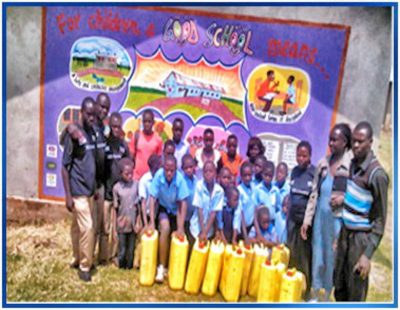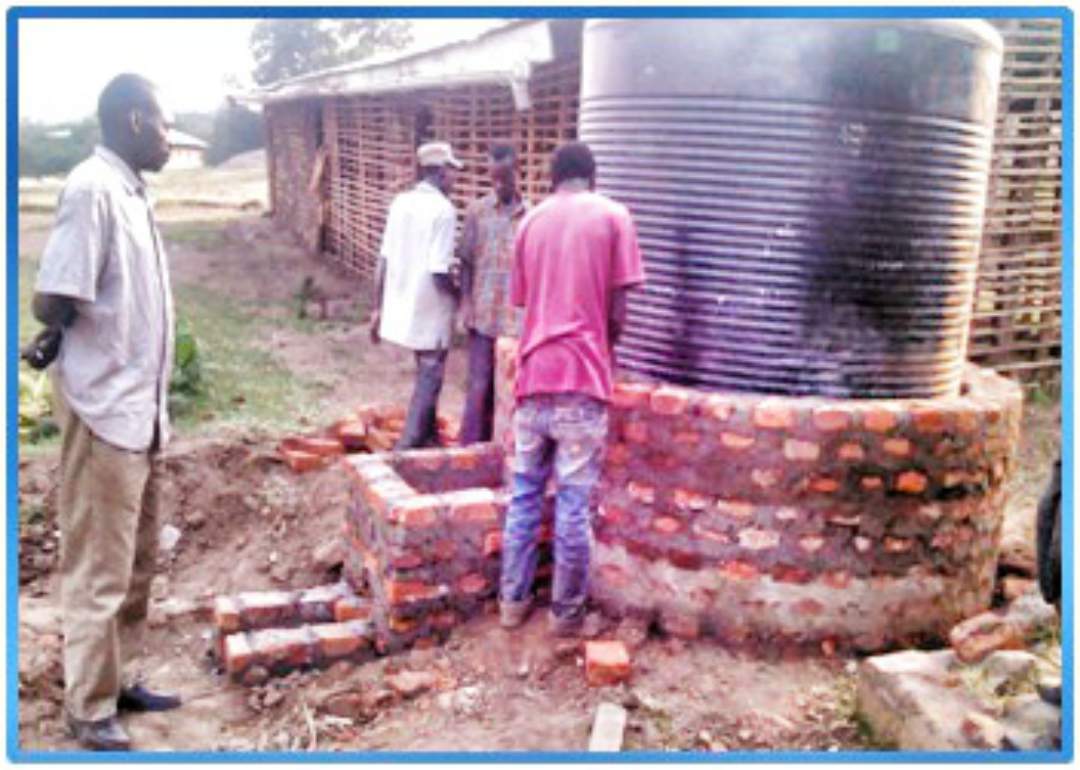This project has been completed under the direction of Returned Peace Corps Volunteer and Peace Corps Recruiter Tiffany Tai.
Three rain harvesting tanks with a capacity of 5,000 liters each, plus above-ground improvements, were completed in 3 schools in Bukuku and Karangura.

To read about the beginning of the project, CLICK HERE.
The following is a conclusion report prepared by Agnes Komuhimo, accountant for TOCI:
Twerwaneho Orphans Community Initiative (TOCI) had an opportunity to implement Water for hard-to-reach areas in the three schools ST, Emmanuel Bubandi, Kazingo SDA, and Nyakitokoli primary schools of Bukuku and Karangura SubCounties in Kabarole District. This was made possible with financial and technical support from Water Charity. We must say that although the project was short-lived it was intensive in terms of work and benefits and the results are vivid and seen both at the community and household levels.
The period was a learning process with many opportunities to reach out to three schools, caregivers and vulnerable children within the beneficiary households whereby during the implementation period TOCI was able to reach a total of over 86 families and three schools, directly benefiting over 1,465 children of whom 772 girls and 693 boys.
Therefore, this report mainly reflects on the core activities, achievements, opportunities and lessons learned, challenges and recommendations of the project. Important to mention was that planned activities were carried out and were able to achieve meaningful results.
The time period of the project recorded fundamental progress in the livelihood of children, schools, teachers, caregivers with significant improvement in household sanitation and hygiene, increased knowledge in maintaining and protecting water sources, bridged the relations of the community  members and local leaders to collaboratively protect the water sources, formation of water user committees and exposed to learning preventative information about dangers of using contaminated water.
members and local leaders to collaboratively protect the water sources, formation of water user committees and exposed to learning preventative information about dangers of using contaminated water.
To refresh our minds, the project’s goal was to increase access to clean water to the villages and schools of Bukuuku and Karangura Sub counties and train them with knowledge and skills to be able to protect and care for the water sources through the formation of water user committees.
The project had 4 major objectives namely:
1) Increase access to clean and reliable water
2) Empowering the community members to manage and protect the water sources.
3) Training the community and schools to set up and adapt better hygiene and sanitary practices.
4) To support vulnerable children with water collection containers to adapt better and safer methods of collecting and storing water
DESCRIPTION OF PLANNED ACTIVITIES AND ACTUAL OUTPUT:
- Holding 3 mobilization and sensitization meetings for caregivers, schools, local and opinion leaders about the improvement of water, hygiene, and sanitation.

Outcome: Over 86 community members mobilized and sensitized about the improvement of water hygiene and sanitation - Constructing and setting up three rain harvesting tanks for three schools
Outcome: Three tanks with a capacity of 5,000 liters were procured, constructed, and fenced for three schools in Bukuku and Karangura sub-counties - Conduct 3 sensitization meetings for three schools and communities about setting up hand washing facilities.
Outcome: Over 1,613 school-going children and caregivers sensitized about setting up handwashing facilities - Conduct 3 mobilization meetings to set up water user and protection committees
Outcome: Three meetings were organized and conducted and three water user and protection committees set up and trained in monitoring and support communities in ensuring regular and timely repairs - Procuring and distributing water containers to vulnerable children and schools
Outcome: Over 200 vulnerable children and three schools received containers for better and safer water collection and storage - Procuring bicycles for water user coordination and monitoring

Outcome: 4 bicycles were procured and handed over to staff and community members to monitor and coordinate the project
Lessons Learned:
A) Community members pledged total support of all the TOCI interventions after awareness of project goals and objectives.
B) Caregivers and school teachers agreed to improve the hygiene and sanitary needs of families and schools and agreed to work with stakeholders in supporting and improving the lives of children
C) Regular planning and coordination meetings improve the committee’s morale to perform. These meetings provide a platform to reflect, discuss, share experience the progress of the project and enable them to receive feedback. This increases their participation in the decision-making process and owning entirely the implementation process. Such meetings further compel committees and leaders take action on key emerging issues that require redress.
 Conclusion
Conclusion
The WAHARA project was quite rewarding in terms of results and relationship building. Already the organization has given an impression and positioned itself in the community as a central partner for socio-economic empowerment, more importantly in addressing the dire needs of caregivers, vulnerable children, and schools.
We wish to applaud Water Charity for considering TOCI’s interventions. We’re grateful for the financial support availed to us in an effort to implement this project. More particularly we thank program director directors, management and Returned Peace Corps volunteer, Tiffany Tai, for the unwavering technical support and amazing teamwork with TOCI Team.
We look forward to the continued support of the partners and the success of the organization.
We would like to thank Tiffany once again for executing this much-needed project.



